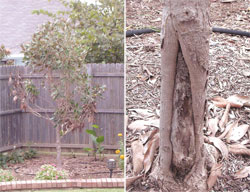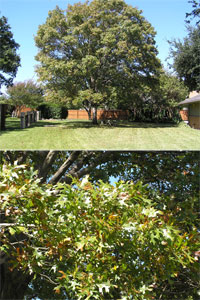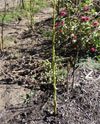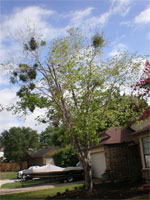Question and Answer – November 2009
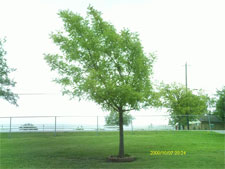
Question: I have a Chinese pistachio tree that is about 8 inches in diameter at the bottom and 15 to 18 feet tall. The trunk is straight, but the top is really leaning. Is there anything I can do to shape the top? D.L., no city given.
Answer: Your tree looks like it’s been windswept by sea breezes. If there is a strong prevailing wind that’s causing this problem, solutions may be temporary. However, as long as the trunk is straight like yours is, off-balanced growth usually can be corrected with just a little judicious pruning in mid-winter, when you can see the branch angles better. Make each cut just above a twig or small branch that faces back toward the center, to direct growth that way.

Question: We have not been able to get this weed under control in spite of the pre-emergent weedkillers we applied last spring and again this fall. What is this, and how can we get rid of it? C.W., Nevada, TX.
Answer: This is roadside aster, and at the risk of losing a friend, I’ll tell you that this is a weed of neglect. It usually crops up at the farthest reaches of our lawns, where it’s most difficult to get water and fertilizer. Your lawn grass will outgrow it if you simply step up your maintenance. Take a look at its wiry little leaves, and if you see them again next year, use a broadleafed weedkiller to kill the plants during the summer. Although this weed has tiny leaves, it is not a grass, and that throws it into the category of weeds that can be controlled with products containing 2,4-D. However, it’s probably money better spent if you just add a bit more nitrogen and water to the grass.
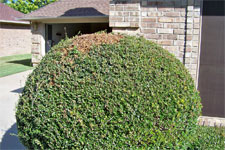
Question: This happens every time I prune this shrub. Can you tell me what is happening, and how I should treat it? It’s been going on for two years now. G., no city given.
Answer: This looks like a standard yaupon holly growing as a shrub (we most often see it trained as a small tree). If that’s the case, it normally would grow to 12 or 15 feet. This may be a branch that broke or died some time in the past, and you may be pruning back to reveal it each time that you cut. Try using lopping shears to remove the dead part of the one branch. New growth should fill in next spring. Eventually, you may want to replace this shrub with one that won’t try to grow so tall and wide. Repeated pruning really stunts a taller plant’s vigor.
Question: We have a four-year-old magnolia that has splits in its trunk from the ground to approximately 8 to 10 inches. The leaves start browning, get brittle and drop off. All of the dead branches were pruned. Is this trunk rot? If so, what can be done to save the tree? The split started three years ago, but last summer the tree started to grow. J.S., no city given.
Answer: "Trunk rot" is a term that really doesn’t say anything specific, either about the damage or its cause. There is very serious decay in this trunk, but you can see that the tree is trying to form a roll of new bark across the wound. The original problem may have been the small branch down near the ground line. It looks like there may have been a stub there that was not removed properly. Decay usually moves up and down from such a jagged stub. Branches that are in direct alignment with the decay are often the ones that die. Your tree may be able to right its course, but there’s not much you can do to help it in the interim. Many gardeners would opt to plant a new tree rather than wait. You could give it next spring and summer to prove itself. If you see progress, leave it in place. If you’re tired of the wait, however, you could also replant right away, now. This is the best time of the entire year to set out new trees.
Question: Just like last year, my 30-year old red oak is dropping its leaves six to eight weeks early. It has been inspected several times, and it has no signs of insect problems. It has been treated twice for some sort of fungus, just in case. Do you have any other suggestions? C.H., Richardson.
Answer: Your tree is gorgeous, and it’s worth getting professional help to its aid. However, the only way to diagnose this tree’s issues is to see it on-site. I very rarely refer to a specific advertiser in my answers, either in print or on the radio. I just don’t think that’s good editorial practice. However, I really want to make sure you make contact. We live in the DFW area, and Arborilogical Services (972-442-1524) does all of the tree work at my house. They have college-degreed horticulturists, pathologists and foresters who are well-schooled in all manners of oak problems. You’ll find their information in their banner ads on my website. I would suggest that you contact them immediately.
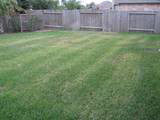
Question: What causes stripes like this in my St. Augustine? I put a national brand of St. Augustine fertilizer on the lawn with a drop-type spreader. The grass has been yellowed since we moved into this house in June. S.R., League City.
Answer: If this is the type of yellowing your lawn has shown all season, it’s due to your drop spreader. While they’re the most precise way of applying fertilizers, it is very difficult to use them without double coverage and missed areas. There are a couple of things you can do in the future. You might do what many of us have done — invest in a rotary-style spreader. And, no matter which type you use, make at least two passes over the lawn at right angles to one another. Apply half or less of the fertilizer with each pass. That will minimize the chance of stripes. For other types of St. Augustine issues involving dying grass, please see the MAQ pages at our website.
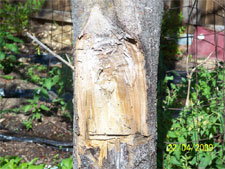
Question: I have a Granny Smith apple tree that had a fungus problem that required considerable pruning. Can I patch this with mortar and save my tree? D.T., no city given.
Answer: Filling cavities with mortar is generally not a good plan. It traps any decay that might be developing, so that it can continue its harm without your having additional access to it. Plus, this wound wouldn’t hold the mortar anyway. Your best bet is to leave it alone and let it heal on its own (don’t even use pruning sealant). If the tree seems weak enough that the trunk might split, you might want to thin out the top growth to take weight off the tree.
Question: I have a medium-sized live oak in my front yard that is suffering from an infestation that I think is referred to as "gall." I have read that it won’t kill the tree, but it’s surely thinning it out. It continually loses many small branches and twigs, and the tree doesn’t appear nearly as healthy as it did four years ago. I’ve tried many insect sprays, all to no avail. Is there nothing to be done? J., North Fort Worth.
Answer: There are literally hundreds of species of insect galls that attack the many types of oaks. They’re the result of an adult insect’s stinging a leaf or twig and depositing eggs. The larvae develop within the plant tissues that form around the wound. Woody oak galls and wooly oak galls are actually much more common than this one. Unless you’re out there spraying when the female insect flies by, you won’t get any control. Systemic insecticides don’t work, either. Your best means of dealing with this problem would be to give it more nitrogen fertilizer and regular waterings during dry spells. Odds are that other years will probably find fewer of these pests.
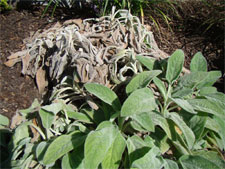
Question: What is wrong with my lamb’s ear? This problem starts in one part of the bed, then spreads to the adjacent plants. A nursery told me it was a fungus. Can we eliminate it? How soon can we replant with more lamb’s ear? N.J., Frisco.
Answer: Most of us who have grown lamb’s ear have seen this summer "melt-out." Many of us decided years ago to use lamb’s ear in smaller pockets, rather than in massed beds. This die-out probably is fungal, but it’s also brought on by our extreme summer heat. The plants weaken, and then this issue shows up. Poorly drained soils also contribute. You also need to remove the flower spikes as soon as they start to grow. The flowers aren’t showy, and they really bring the plants’ vigor down dramatically.
Question: What is causing the leaves to fall from my okra plants? It seems to happen late every year. E.S., Denison.
Answer: Some insect pest is apparently stripping the foliage. In Southeast Texas, leaf cutter ants would be suspected. Watch the plants closely to see if you can find any type of insect. It’s not a perfect answer, but hopefully will give you some direction.
Question: I believe this is a silver maple, as the roots are all growing on top of the soil. Should we try to nurse this tree back to health, or just start over? I know we need to remove the mistletoe. What tree do you suggest in this small front yard? K.G., Grapevine.
Answer: It does look like a silver maple, and a weak one at that. By the time you paid someone to remove all that mistletoe and the dead branches as well, you’d probably wish you had simply planted a Little Gem magnolia, golden raintree, Lacey oak or other small tree. As a side issue, it looks like the bed beneath this tree may have been worked up for the shrub plantings. If the grade was changed by much, or if roots were cut in the process, those could account for the tree’s decline.
Question: We have had this problem more than two years — a bare ring around the 35-year-old red oak. We have tried sodding, but nothing will grow. The ring is not at the drip line, but quite a bit inside. C. and L. Moore.
Answer: Shade is definitely involved, although I’ll have to admit that the circular pattern is odd, almost like you’d see after transplanting a large balled-and-burlapped tree. Perhaps this is a path caused by walking around the retaining wall as you work in the yard. I suspect that the shade will be too heavy to get new sod established, so you may want to consider a groundcover or low shrub to fill in the void.


